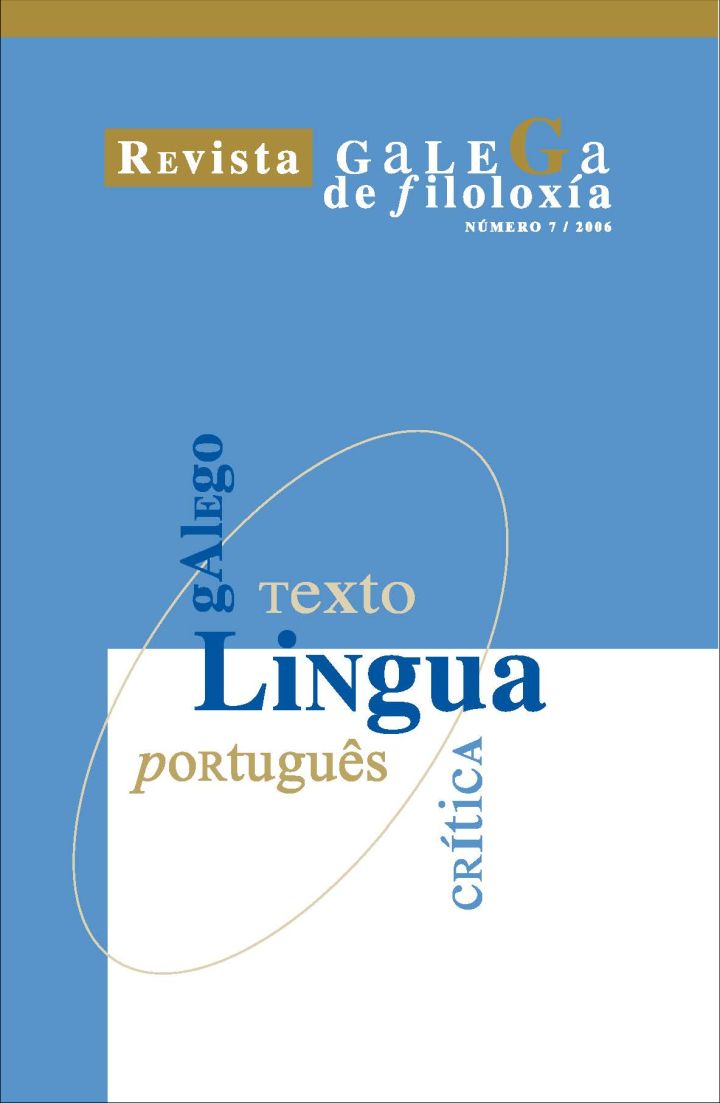Falocentrismo e heteronormatividade na tradución: de como varren as mulleres e as lesbianas da historia cun golpe de penæ
Contido principal do artigo
Resumo
Este artigo interdisciplinar parte de estudos baseados na tradución como ferramenta metodolóxica para indagar na maneira en que as/os tradutoras/es entendidas/os como usuarias/os arquetípicas/os da linguaxe poden proxectar mediante o uso inapropiado da linguaxe normas heterosexistas socialmente dominantes sob o pretexto de seren de interpretacións neutrais.
Máis especificamente, aborda a cuestión das normas androcéntricas que rexen a linguaxe e que levan, por forza, a estereótipos sexuais e de xénero no xeral e ao heterosexismo en particular. Alén de analizar instancias nas que a tradución ten sido utilizada de maneira consciente para censurar papeis de xénero que se sitúen fóra das normas falocéntricas, e máis especialmente a sexualidade feminina, dentro do cadro teórico de xénero latente (covert) face axénero patente (overt) asociado cos conceptos relacionados de denotación e connotación semántica, o artigo afunda na maneira en que poden ser útiles exercicios baseados na tradución construídos ao redor de pares de linguas que non marcan o xénero gramaticalmente con outras que si o marcan de maneira obrigatoria para así tornar visíbeis calquera preconceptos até inclusive inconscientes por parte das/os propias/os tradutora/es. A un nivel xa máis amplo, o artigo tenta desvelar as potenciais implicacións que leva parello a tradución como un medio que serve para censurar non só sexualidades socialmente marxinalizadas senón tamén para proxectar determinadas visións ideoloxizadas do que se entende como normal ou non, o que leva á necesidade de as tradutoras e os tradutores se tornaren máis conscientes e responsábeis a respecto das súas propias expectativas social e culturalmente condicionadas.
Palabras clave:
Descargas
Métricas
Detalles do artigo
Citas
Ager, S. (1998-2004): "Nushu", en Ager, S, Omniglot, http://www.omniglot.eom/writing/nushu.htm.
Baxter, R.N. (2005): "On the need for non-sexist language in translation", en Thao Le (2005), Language, Society and Culture, 15 http://www.edue.utas.edu.au/users/tle/JOURNAL/ARTICLES/2005/15-1.htm
Bodine, A. (1975): "Androcentrism in prescriptive grammar: singular 'they', sex-indefinite 'he', and 'he or she"', Language in Society, 4 (2): 129-146.
Boulter, A. (2002): Around the Houses (London: Serpent's Tail).
Braun, F. (2001): "The Communication of Gender in Turkish", en Hellinger, M / Bußmann, H. (eds.) (2001), Gender across languages. Vol. 1: 283-310 (Amsterdam / Filadelfia: John Benjamins).
Casavent, J. (2003): Twist of Fate (Nederland: Yellow Rose Books).
Colin, S. / Koşar, S. (1997): Le turc tout de suite (París: Pocket-Langues pour tous).
Dworkin, A. (1994): "The Unremembered: Searching for Women at the Holocaust Memorial Museum", Ms. Magazine, Vol. V, 4: 5258.
Engelberg, M. (2002): "The Communication of Gender in Finnish", en Hellinger, M. / Bußmann, H. (eds.) (2002), Gender across languages. Vol. 2: 109-132 (Amsterdam / Filadelfia: John Benjamins).
European Commission (1995-2005): "Gender Mainstreaming", en Europa http://europa.eu.int/comm/employment_social/equ_opp/gms_en.html.
Even-Zohar, l. (1990): "Polysystem Studies", International Joumal For Theory and Analysis of Literature and Communication. Vol. 11, 1, http://www.ifrance.com/itamarez/ps/polysystem.html.
Fillmore, C. J. (1976): "Frame semantics and the nature of language", Annals of the New York Academy of Sciences: Conference on the Origin and Development of Language and Speech, 280: 20-32.
Von Flotow, L. (1997): Translation and Gender. Translating in the 'Era of Feminism'(Manchester / Ottawa: St. Jerome Publishing e University of Ottawa Press).
Frank, A. / Hoffmann, C. / Strobel, M. (2004): "Gender Issues in Machine Translation", en International Symposium Gender Perspectives Increasing Diversity for Information Society Technology (GIST) (Bremen 2003) (Heidelberg: Lingenio).
Garréta, A. F. (1999): La Décomposition (París: Grasset et Fasquelle).
Haden Elgin, S. (1988): A First Dictionary and Grammar of Laadan (Society for the Furtherance and Study of Fantasy and Science Fiction, Inc).
Hellinger, M. / Bußmann, H. (2001): "Gender across language. The Linguistie Representation of Women and Men", en Hellinger, M. / Bußmann, H. (eds.) (2001), Gender across languages, Vol. 1: 1-25 (Amsterdam / Filadelfia: John Benjamins).
de Lotbinière-Harwood, S. (1991): Re-belle et infidèle. La traduction comme pratique de réécriture au féminin / The Body Bilingual. Translation as rewriting in the feminine (Ontario / Quebec: Woman's Press e Éditions du remue-ménage).
Martín Ruano, M.R. (2003): El (des)orden en los discursos: la traducción de lo políticamente correcto. Tese de doutoramento en formato dixital (Granada: Universidad de Granada)
Minsky, M. (1975): "A framework for representing knowledge", en The Psychology of Computer Vision: 211-277 (Nova lorque: McGraw-Hill).
Nissen, U.K. (1994): "Is cook 'der Koch' oder 'die Kochin'? Problems of (social) gender in translation", Hermes. Zeitschriftfür Klassische Philologie, 12: 51-63.
Nissen, Uwe Kjær (2002): "Aspects of Translating Gender", en Hentschel, E. (ed.) (2002), Sprache und Geschlecht/Language and Gender, Linguistik on-line, 11, 2/02. http://www.linguistik-online.de/11_02/nissen.pdf.
Riera, C. (1989): Te deix, amor, la mar com a penyora (Barcelona: Laia).
Rice, C. (2001): Snow Garden (Nova lorque: Miramax Books).
Rich, A. (1979): On Lies, Secrets and Silence: Selected Prose: 1966-78 (Nova lorque: Norton).
Sedgwick, E.K. (1995): Performativity and Performance (Essays from the English Institute) (Nova lorque e Londres: Routledge).
Simons, M. A. (1983): "The Silencing of Simone de Beauvoir: Guess What's Missing from the Second Sex", Women's Studies International Forum, 6, n° 5.
Smith, N. (2002): Language, Bananas & Bonobos. Linguistic Problems, Puzzles and Polemics (Oxford: Blackwell).
Spender, D. (1985): Man made language (London: Routledge & Kegan Paul).
Toury, G. (1981): "Translated Literature - System, Norm, Performance: Toward a TT-Oriented Approach to Literary Translation", en Poetics Today, 11, 4 (Tel Aviv: The Porter Institute for Poetics and Semiotics).
VV.AA. (2006): "Lesbian", en Wikipedia, The Free Encyclopedia. http://en.wikipedia.org/w/index.php?title=Lesbian&oldid=40553903.
VV.AA. (2006): "Sappho", en An encyclopedia of gay, lesbian, bisexual, transgender and queer culture (Chicago: Gbltq, Inc.). http://www.glbtq.com/literature/sapp-ho,3.html.
Wandruszka, M. (1969): Sprachen: vergleichbar und unvergleichbar (Munique: R. Piper).
Whorf, B. (1964): Language, Thought, and Reality: Selected Writings of Benjamin Lee Whorf (Cambridge-Boston: MIT Press).



